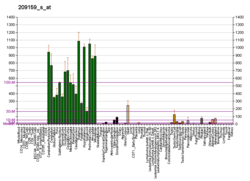NDRG4
Protein NDRG4 is a protein that in humans is encoded by the NDRG4 gene.[5][6][7]
This gene is a member of the N-myc downregulated gene family which belongs to the alpha/beta hydrolase superfamily. The protein encoded by this gene is a cytoplasmic protein that may be involved in the regulation of mitogenic signalling in vascular smooth muscles cells. Several alternatively spliced transcript variants of this gene have been described, but the full-length nature of some of these variants has not been determined.[7]
References
- GRCh38: Ensembl release 89: ENSG00000103034 - Ensembl, May 2017
- GRCm38: Ensembl release 89: ENSMUSG00000036564 - Ensembl, May 2017
- "Human PubMed Reference:". National Center for Biotechnology Information, U.S. National Library of Medicine.
- "Mouse PubMed Reference:". National Center for Biotechnology Information, U.S. National Library of Medicine.
- Zhou RH, Kokame K, Tsukamoto Y, Yutani C, Kato H, Miyata T (May 2001). "Characterization of the human NDRG gene family: a newly identified member, NDRG4, is specifically expressed in brain and heart". Genomics. 73 (1): 86–97. doi:10.1006/geno.2000.6496. PMID 11352569.
- Hongo S, Watanabe T, Takahashi K, Miyazaki A (Apr 2006). "Ndrg4 enhances NGF-induced ERK activation uncoupled with Elk-1 activation". J Cell Biochem. 98 (1): 185–93. doi:10.1002/jcb.20763. PMID 16408304.
- "Entrez Gene: NDRG4 NDRG family member 4".
Further reading
- Nakajima D, Okazaki N, Yamakawa H, et al. (2003). "Construction of expression-ready cDNA clones for KIAA genes: manual curation of 330 KIAA cDNA clones". DNA Res. 9 (3): 99–106. doi:10.1093/dnares/9.3.99. PMID 12168954.
- Andersson B, Wentland MA, Ricafrente JY, et al. (1996). "A "double adaptor" method for improved shotgun library construction". Anal. Biochem. 236 (1): 107–13. doi:10.1006/abio.1996.0138. PMID 8619474.
- Yu W, Andersson B, Worley KC, et al. (1997). "Large-Scale Concatenation cDNA Sequencing". Genome Res. 7 (4): 353–8. doi:10.1101/gr.7.4.353. PMC 139146. PMID 9110174.
- Hirosawa M, Nagase T, Ishikawa K, et al. (2000). "Characterization of cDNA clones selected by the GeneMark analysis from size-fractionated cDNA libraries from human brain". DNA Res. 6 (5): 329–36. doi:10.1093/dnares/6.5.329. PMID 10574461.
- Hartley JL, Temple GF, Brasch MA (2001). "DNA Cloning Using In Vitro Site-Specific Recombination". Genome Res. 10 (11): 1788–95. doi:10.1101/gr.143000. PMC 310948. PMID 11076863.
- Wiemann S, Weil B, Wellenreuther R, et al. (2001). "Toward a Catalog of Human Genes and Proteins: Sequencing and Analysis of 500 Novel Complete Protein Coding Human cDNAs". Genome Res. 11 (3): 422–35. doi:10.1101/gr.GR1547R. PMC 311072. PMID 11230166.
- Qu X, Zhai Y, Wei H, et al. (2002). "Characterization and expression of three novel differentiation-related genes belong to the human NDRG gene family". Mol. Cell. Biochem. 229 (1–2): 35–44. doi:10.1023/A:1017934810825. PMID 11936845.
- Ohki T, Hongo S, Nakada N, et al. (2002). "Inhibition of neurite outgrowth by reduced level of NDRG4 protein in antisense transfected PC12 cells". Brain Res. Dev. Brain Res. 135 (1–2): 55–63. doi:10.1016/S0165-3806(02)00300-0. PMID 11978393.
- Strausberg RL, Feingold EA, Grouse LH, et al. (2003). "Generation and initial analysis of more than 15,000 full-length human and mouse cDNA sequences". Proc. Natl. Acad. Sci. U.S.A. 99 (26): 16899–903. doi:10.1073/pnas.242603899. PMC 139241. PMID 12477932.
- Nishimoto S, Tawara J, Toyoda H, et al. (2003). "A novel homocysteine-responsive gene, smap8, modulates mitogenesis in rat vascular smooth muscle cells". Eur. J. Biochem. 270 (11): 2521–31. doi:10.1046/j.1432-1033.2003.03626.x. PMID 12755708.
- Ota T, Suzuki Y, Nishikawa T, et al. (2004). "Complete sequencing and characterization of 21,243 full-length human cDNAs". Nat. Genet. 36 (1): 40–5. doi:10.1038/ng1285. PMID 14702039.
- Gerhard DS, Wagner L, Feingold EA, et al. (2004). "The Status, Quality, and Expansion of the NIH Full-Length cDNA Project: The Mammalian Gene Collection (MGC)". Genome Res. 14 (10B): 2121–7. doi:10.1101/gr.2596504. PMC 528928. PMID 15489334.
- Wiemann S, Arlt D, Huber W, et al. (2004). "From ORFeome to Biology: A Functional Genomics Pipeline". Genome Res. 14 (10B): 2136–44. doi:10.1101/gr.2576704. PMC 528930. PMID 15489336.
- Mehrle A, Rosenfelder H, Schupp I, et al. (2006). "The LIFEdb database in 2006". Nucleic Acids Res. 34 (Database issue): D415–8. doi:10.1093/nar/gkj139. PMC 1347501. PMID 16381901.
This article is issued from Wikipedia. The text is licensed under Creative Commons - Attribution - Sharealike. Additional terms may apply for the media files.




